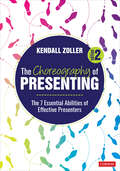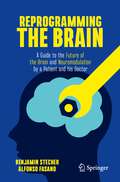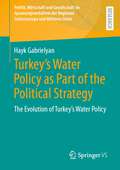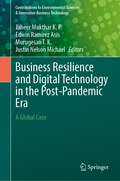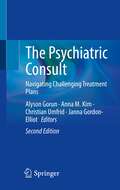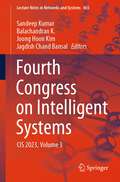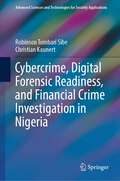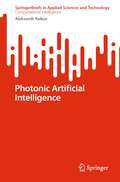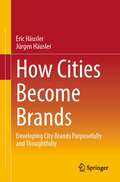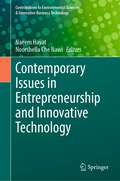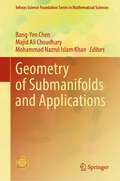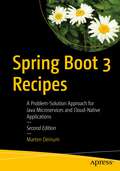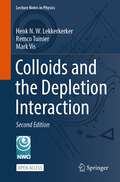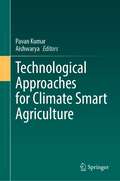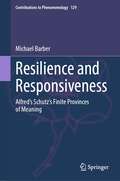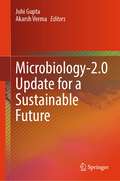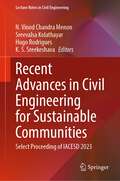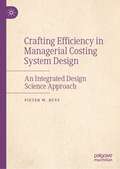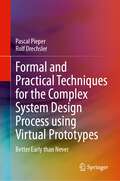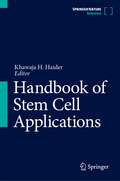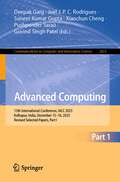- Table View
- List View
The Choreography of Presenting: The 7 Essential Abilities of Effective Presenters
by Kendall V. ZollerDramatically increase your effectiveness as a presenter Like a well-choreographed dance, an effective presentation involves leading and following, building rapport and trust, sharing passions, and living in the moment. In The Choreography of Presenting, global consultant and educator, Kendall Zoller reveals the common "dance steps" effective presenters employ to create optimum learning environments for their audiences. Following the 7 Essential Abilities of Effective Presenters Framework and emphasizing the importance of planning and flexibility, this thoroughly updated edition includes: A new chapter on how to use the crucial first 5 minutes of any presentation to establish credibility, build connections, and gauge group dynamics A new, timely chapter on designing and facilitating impactful and memorable virtual presentations A new chapter on the structure of presenting, from gathering intel to design with an inward look at yourself Planning tools to prepare presentations with the audience in mind, while also leaving room for spontaneity, improvisation, and necessary detours Personal reflections, case studies, practice prompts, and chapter summaries Written in a welcoming and humorous style, this guide encapsulates the skills, knowledge, and abilities that effective presenters rely on to ignite their participants’ passion for learning.
Reprogramming the Brain: A Guide to the Future of the Brain and Neuromodulation by a Patient and his Doctor
by Benjamin Stecher Alfonso FasanoIn June 2021, Doctor and Patient decided that time had come to surgically implant two six-inch-long metal alloy spikes all the way through Ben’s brain. It was felt that the medications Ben was taking to control his Parkinson’s disease had become unmanageable. Back then, Ben was taking about 20 different pills a day. Each pill, if it absorbed properly, would activate the dopamine pathways in his brain and induce uncontrollable writhing movements that would last for about an hour. He would then get about 20 minutes where he’d feel somewhat normal before the slowness and tremor kicked in again. So, he’d take another pill and the cycle would repeat.After months of adjusting his medication and finding just the right settings on his deep brain stimulator, it was decided, for the first time ever in a clinical trial in North America, to flip on the adaptive settings.This is the story of how that decision was made and what happened next.
Turkey's Water Policy as Part of the Political Strategy: The Evolution of Turkey's Water Policy (Politik, Wirtschaft und Gesellschaft im Spannungsverhältnis der Regionen Südosteuropa und Mittlerer Osten)
by Hayk GabrielyanThis book investigates water issues in the Euphrates-Tigris basin between Turkey, Syria and Iraq (Iran). It presents the importance of water in the world and especially for the countries of the Euphrates-Tigris basin, the water resources of the three riparian countries, their advantages and disadvantages, the amount of reservoir construction in the three riparian countries, their water disagreements and conflicts, international water law. The importance of water in the Ottoman period is presented, the evolution of Turkey's water policy in the 20th and 21st centuries, the connection and interdependence of Turkey's water policy with its foreign and domestic policies are shown in detail. Separate reference is made to non-state actors, such as the Kurds of Turkey, Syria and Iraq. The work emphasizes that Turkey is a unique country in the world with its water policy in the Euphrates-Tigris basin: no other country is able to use water in such a multi-purpose way to achieve various goals.
Business Resilience and Digital Technology in the Post-Pandemic Era: A Global Case (Contributions to Environmental Sciences & Innovative Business Technology)
by Jaheer Mukthar K.P. Edwin Ramirez Asis Murugesan T. K. Justin Nelson MichaelThis book throws a light on sustainable perspectives of how business entities experienced the turbulent environment in the light of pandemic. The post-pandemic era is characterized by the radical and dramatic changes in the business model, corporate strategies and digital technology. This book provides the academicians, research scholars and corporate professionals with a thought-provoking forum to discuss and deliberate the major trends, opportunities and issues of business entity from the outlook of business resilience, corporate strategy and digital technology in the light of post-pandemic era. The book also suggests suitable measures and strategies for the sustainable development of business entities.
The Psychiatric Consult: Navigating Challenging Treatment Plans
by Alyson Gorun Anna M. Kim Christian Umfrid Janna Gordon-ElliotThis book guides psychiatry trainees through some of the most common psychiatric consultation requests in the general medical hospital, using accessible, case-based narratives. Clinical case scenarios are used to demonstrate how to consider both medical and psychological factors involved in the consultation, and the approach to challenging interpersonal dynamics that may occur between the hospitalized patient and the primary medical team. Each case illustrates how to begin to think like a consultation-liaison psychiatrist in order to arrive at a diagnosis and formulate a treatment plan in complex clinical situations. Cases unfold in real time to highlight the critical role of the psychiatrist as liaison to the patient and medical team in order to guide psychiatric management and facilitate effective communication and treatment in the hospital. In addition to clinical cases, each chapter features a concise list of strategies to identify and address patient symptoms and behaviors, interpersonal dynamics, and barriers to care that arise in the hospital. The Psychiatric Consult features resident-specific recommendations and a case-based format that make it a unique, realistic, and engaging learning tool.
Fourth Congress on Intelligent Systems: CIS 2023, Volume 3 (Lecture Notes in Networks and Systems #865)
by Sandeep Kumar Balachandran K. Joong Hoon Kim Jagdish Chand BansalThis book is a collection of selected papers presented at the Fourth Congress on Intelligent Systems (CIS 2023), organized by CHRIST (Deemed to be University), Bangalore, India, under the technical sponsorship of the Soft Computing Research Society, India, during September 4–5, 2023. It includes novel and innovative work from experts, practitioners, scientists, and decision-makers from academia and industry. It covers topics such as the Internet of Things, information security, embedded systems, real-time systems, cloud computing, big data analysis, quantum computing, automation systems, bio-inspired intelligence, cognitive systems, cyber-physical systems, data analytics, data/web mining, data science, intelligence for security, intelligent decision-making systems, intelligent information processing, intelligent transportation, artificial intelligence for machine vision, imaging sensors technology, image segmentation, convolutional neural network, image/video classification, soft computing for machine vision, pattern recognition, human-computer interaction, robotic devices and systems, autonomous vehicles, intelligent control systems, human motor control, game playing, evolutionary algorithms, swarm optimization, neural network, deep learning, supervised learning, unsupervised learning, fuzzy logic, rough sets, computational optimization, and neuro-fuzzy systems.
Cybercrime, Digital Forensic Readiness, and Financial Crime Investigation in Nigeria (Advanced Sciences and Technologies for Security Applications)
by Robinson Tombari Sibe Christian KaunertNigeria has become one of the hotbeds of cybercrime since the liberalization of the telecommunication industry began in 1996. The scale and magnitude have been quite disturbing, not just for Nigeria but also for the international community, given the limitless boundaries of cybercrime. Like any other type of fraud, Internet fraud is primarily driven by financial gains. This book investigates the extent of the lack of digital forensic resources in Nigeria’s financial crime agencies. It is vital to have a proper resource inventory and capabilities to successfully confront the growing threat of financial crimes. While a few studies have suggested the lack of forensic capabilities in Nigerian cybercrime investigative agencies and the justice system, none have examined this in great detail, particularly in relation to specific skills gaps and resources needed in Nigeria’s financial crime agencies. This book contributes to the growing body of knowledge and clarifies the scope of the lack of digital forensic resources. Understanding the extent of the deficiency and its impact on caseloads could be crucial for developing a roadmap toward building forensic readiness and capability maturity for the agencies. This book presents the deficiencies in forensic readiness and recommends measures to fill this gap. This book also examines the specifics of the cybercrime caseloads and conviction records in Nigeria, identifying trends and patterns. The book explores other cybercrime complexities in Nigeria, such as common cybercrime taxonomies, prosecution, and conviction dynamics, juxtaposing it with select case studies in other jurisdictions. Drawing on extensive research, the book offers crucial insights for policymakers, researchers, and the public interested in new trends in cybercrime, digital forensic readiness, Nigerian financial crime agencies, and cybercrime investigations.
Photonic Artificial Intelligence (SpringerBriefs in Applied Sciences and Technology)
by Aleksandr RaikovThis book addresses an attempt to create Photonic Artificial Intelligence (PAI) system based on optical technologies, which process signals continuously. PAI could help to overcome digital computer limits and almost zero out the machine learning time and AI inference. It helps to consider feelings, the chaos of thoughts, cognitive activity, and the transcendental states of the human mind in AI systems. The book also discusses new problems such as synthesizing new photonic materials, creating optical control systems, and connecting PAI systems with outside digital computers and holographic memory. The book is aimed at a wide range of readers, including postgraduates and researchers, interested in advanced AI by creating its new paradigm, which can help to overcome traps of traditional AI development.
How Cities Become Brands: Developing City Brands Purposefully and Thoughtfully
by Eric Häusler Jürgen HäuslerThis book explores how the fragile and lengthy process of developing a city brand can be carefully managed. Necessary background information is explained, numerous experiences are reported, and targeted city branding is inspired in a variety of ways.The dream of every brand maker: to develop a city into a strong city brand - perhaps even a myth. The creation of myths remains a curiosity. Is it targeted, are there relevant recipes for success, and can those responsible be identified? Above all: Can the process be replicated? How do brand makers deal with the complexity of the phenomena of cities and city brands? How do they give the arduous process of creating a city brand a reasonable chance of success? How do brand makers deal with the often biting criticism from outside and the nagging self-doubt?Successful cityscapes arise from the trials and tribulations of complex and sometimes random processes. In the course of global city competition, this evolutionaryprocess is enriched with the achievements of the craft of branding. This is not a guarantee of success. Success depends on numerous prerequisites, which are discussed in detail. Finally, craft rules for good and at the same time sensitive city branding are mentioned.The translation was done with the help of artificial intelligence. A subsequent human revision was done primarily in terms of content.nal criticism and self-doubts?City images emerge from complex and random processes. In global urban competition, this process is enriched with brand making achievements. Success isn't guaranteed, depending on discussed conditions. Lastly, rules for effective city branding are outlined.nal criticism and self-doubts?City images emerge from complex and random processes. In global urban competition, this process is enriched with brand making achievements. Success isn't guaranteed, depending on discussed conditions. Lastly, rules foreffective city branding are outlined.nal criticism and self-doubts?City images emerge from complex and random processes. In global urban competition, this process is enriched with brand making achievements. Success isn't guaranteed, depending on discussed conditions. Lastly, rules for effective city branding are outlined.nal criticism and self-doubts?City images emerge from complex and random processes. In global urban competition, this process is enriched with brand making achievements. Success isn't guaranteed, depending on discussed conditions. Lastly, rules for effective city branding are outlined.nal criticism and self-doubts?City images emerge from complex and random processes. In global urban competition, this process is enriched with brand making achievements. Success isn't guaranteed, depending on discussed conditions. Lastly, rules for effective city branding are outlined.nal criticism and self-doubts?City images emergefrom complex and random processes. In global urban competition, this process is enriched with brand making achievements. Success isn't guaranteed, depending on discussed conditions. Lastly, rules for effective city branding are outlined.nal criticism and self-doubts?City images emerge from complex and random processes. In global urban competition, this process is enriched with brand making achievements. Success isn't guaranteed, depending on discussed conditions. Lastly, rules for effective city branding are outlined.City images emerge from complex and random processes. In global urban competition, this process is enriched with brand making achievements. Success isn't guaranteed, depending on discussed conditions. Lastly, rules for effective city branding are outlined.City images emerge from complex and random processes. In global urban competition, this process is enriched with brand making achievements. Success isn't guaranteed, depending on discussedconditions. Lastly, rules for effective city branding are outlined.City images emerge from
Cellular and Molecular Aspects of Ageing
by Valquiria BuenoEven though life expectancy increased in the last decades, ageing has been considered a strong risk factor for age-related diseases, disability and death. The further understanding of cellular and molecular aspects of ageing could predict the onset of diseases in advance, prevent functional decline and identify targets for interventions focused in healthy ageing. The hypothesis that organismal ageing and dysfunction is influenced by the accumulation of senescent cells had origin in Hayflick and Moorhead results from cultured human fibroblasts. It was shown that fibroblasts presented a limited capacity for proliferation reaching thus the state of irreversible growth arrest (replicative senescence). In 2011, van Deusen et al. showed that p16Ink4a accumulation was associated with premature ageing in a mouse model and the inactivation of the p16Ink4a gene mitigated the ageing phenotype. Thus, the cell cycle arrest due to the expression of p16Ink4a and p21CIP (cell cycle inhibitors) is the main characteristic of senescence. In addition to cellular senescence, the hallmarks of ageing include genomic instability, telomere shortening , epigenetic alterations, loss of proteostasis, deregulated nutrient-sensing, mitochondrial dysfunction, stem cell exhaustion, altered intercellular communication, and a pro-inflammatory senescence-associated secretory phenotype (SASP). In this book, researchers will comprehensively discuss relevant changes occurring at cellular and molecular levels (human and animal models) based on the hallmarks of ageing. The impact of lifestyle and benefits of physical activity and nutrition will be also discussed. Unravelling cellular and molecular aspects of ageing is crucial for the unanswered questions about ageing and for guiding interventions such as changes in lifestyle, senolytic (kills senescent cells), and senomorphic (interrupts deleterious intercellular communication) therapies.
Contemporary Issues in Entrepreneurship and Innovative Technology (Contributions to Environmental Sciences & Innovative Business Technology)
by Naeem Hayat Noorshella Che NawiThe book offers state-of-the-art information in the field of entrepreneurship, business management, the role of technology to manage entrepreneurial firms, and innovation and social aspects of firms. The book also offers quality research with quantitative and qualitative designs offering insights into the emerging business trends among the entrepreneurial firms. The volume supports early career researchers and students looking for research acumen in small business and entrepreneurship.
Smell, Taste, Eat: The Role of the Chemical Senses in Eating Behaviour
by Lorenzo D. StaffordThis edited collection synthesises recent research into smell and taste and relates it to eating behaviour. Olfaction - the sense of smell - together with taste are known as the ‘chemical senses’ and are the oldest sensory system. It is paradoxical then that our knowledge (especially psychological) about these two systems remains far behind that of vision and audition. Nevertheless, the past twenty years has seen a significant increase in our understanding of these sensory systems and the contributors to this book, many of whom helped to reveal key findings in this research domain, explore theories which attempt to explain appetite control, associative odour learning and multisensory perception, among others. It further brings the reader up to date on the current state of knowledge on disordered eating and olfactory disorders. Finally, it bridges across different academic disciplines to reveal the importance of the chemical senses in indigenous people in Guyana.
Mit ADHS erfolgreich im Beruf: So wandeln Sie vermeintliche Schwächen in Stärken um
by Heiner LachenmeierWas ist ADHS, und vor allem, wie verhalten sich Menschen mit ADHS? Was bedeutet das für das Erleben der Betroffenen, welchen Einfluss hat es auf ihren Zugriff auf ihre Fähigkeiten, und wie wirkt sich das auf das Arbeitsleben aus?Ausgehend von diesen Fragestellungen zeigt der Autor aus wissenschaftlicher Sicht und in leicht verständlicher, gut konsumierbarer und humorvoller Weise auf, wie sich ADHS auf das Arbeitsleben auswirkt und welche Chancen sich mit einem besseren Verständnis dieser neurologischen Variante auftun können. Denn unter bestimmten Bedingungen kann ADHS in einigen Arbeitsbereichen klare Vorteile bieten! Selbstverständlich werden aber auch mögliche Schwierigkeiten im Berufsleben beleuchtet und dafür konkret umsetzbare Lösungswege aufgezeigt. Leser mit und ohne ADHS werden die spezielle Aufarbeitung dieses wichtigen Themas ebenso schätzen wie die leichte Umsetzbarkeit der vielen praktischen Tipps&Tricks, die aus zahlreichen Studien und der langjährigen intensiven Arbeit des Autors mit Betroffenen – und dem eigenen ADHS - resultieren. Jugendliche und junge Erwachsene und deren Eltern finden hilfreiche Unterstützung, um erfolgreich in der Arbeitswelt durchzustarten – mit, trotz oder gerade wegen ADHS! Für die 2. Auflage wurde das Buch gründlich überarbeitet und erweitert, alle Abbildungen sind nun in Farbe enthalten. Neue Kapitel bieten weitere Anregungen aus dem reichhaltigen Fundus des Autors: Der Leser erfährt, wie Angst und Mut bei ADHS miteinander Hand in Hand gehen, wie Berufsbeziehungen bei ADHS gut gelingen und wie ein Perspektivwechsel gewinnbringend für Arbeitgeber und Arbeitnehmer mit ADHS sein kann. In Anerkennung des Interesses der Vorgesetzten und Arbeitgeber, die dieses Buch lesen, wird mit einer Tabelle ein schneller Überblick der wichtigsten beruflichen ADHS-Situationen, deren Hintergründe und Tipps zum Umgang damit geboten.
Geometry of Submanifolds and Applications (Infosys Science Foundation Series)
by Bang-Yen Chen Majid Ali Choudhary Mohammad Nazrul Islam KhanThis book features chapters written by renowned scientists from various parts of the world, providing an up-to-date survey of submanifold theory, spanning diverse topics and applications. The book covers a wide range of topics such as Chen–Ricci inequalities in differential geometry, optimal inequalities for Casorati curvatures in quaternion geometry, conformal η-Ricci–Yamabe solitons, submersion on statistical metallic structure, solitons in f(R, T)-gravity, metric-affine geometry, generalized Wintgen inequalities, tangent bundles, and Lagrangian submanifolds.Moreover, the book showcases the latest findings on Pythagorean submanifolds and submanifolds of four-dimensional f-manifolds. The chapters in this book delve into numerous problems and conjectures on submanifolds, providing valuable insights for scientists, educators, and graduate students looking to stay updated with the latest developments in the field. With its comprehensive coverage and detailed explanations, this book is an essential resource for anyone interested in submanifold theory.
Spring Boot 3 Recipes: A Problem-Solution Approach for Java Microservices and Cloud-Native Applications
by Marten DeinumSolve all your Spring Boot 3 micro-framework problems using complete, real-world Java-based code snippets and examples inspired by various problems and corresponding solutions to those problems . When you start a new project, you’ll be able to copy the code and configuration files from this book, and then modify them for your own specific software programming needs. This can save you a great deal of work over creating a project from scratch.Spring Boot 3 Recipes has been revised to include new features like the new Spring Native, newly repackaged Spring Data, Spring Kafka for messaging and more on Kubernetes/deployment than in the previous edition. It includes Java 17 long term support code and Jakarta EE 9+ code as a base for Spring Boot 3. This handy code reference takes advantage of these things as it introduces you to VMWare's Spring Boot 3 and Spring Native. Quickly, it dives into code snippets on how to apply and integrate SpringBoot 3 with the Spring MVC web framework, web sockets and WebFlux for the rapid development of web applications, web services, microservices and more. You'll also get solutions to common problems with data persistence, integrating Spring Boot with batch processing, algorithmic programming via Spring Batch, and much more. These enable you to enhance or round out your web applications or microservices with a data and/or transaction-tier to boot. Other recipes cover topics such as using and integrating Boot with Spring's enterprise services, Spring Integration, testing, monitoring and more.At the end of the book, you'll have the code snippets and packages to deploy your Spring Boot-created microservices or applications on a cloud platform like Amazon using the popular Kubernetes container. Finally, this code reference is a must have for your Spring library. What You'll LearnGet reusable code recipes and snippets for the Spring Boot 3 micro-framework Discover how Spring Boot 3 integrates with other Spring APIs, tools, and frameworksAccess Spring MVC, web sockets and WebFlux for easier web developmentWork with microservices for web services development and integration with your Spring Boot applicationsAdd persistence and a data tier seamlessly to make your Spring Boot web application do moreIntegrate enterprise services via Spring Integration and Jakarta EE to create a more complex Java application using Spring BootWho This Book Is ForThis book is for experienced Java and Spring software programmers, developers.
Colloids and the Depletion Interaction (Lecture Notes in Physics #1026)
by Henk N.W. Lekkerkerker Remco Tuinier Mark VisThis open access book provides a detailed exploration of the phase behaviour of, and interfacial properties in, complex colloidal mixtures (e.g., clay, milk, blood). Insights into colloids have been at the heart of many innovations in different industries. The big question underlying these innovations is how can colloidal systems be formulated and designed towards the desired properties? To do this, the forces between the colloidal particles need to be controlled. Adding depletants (non-adsorbing polymers or small colloids) is key to controlling the attractive interactions. Colloids and the Depletion Interaction provides the qualitative insights and quantitative tools to understand and predict such forces in colloidal dispersions. It offers a concise introduction to the history and fundamentals of the depletion interaction in, and phase behaviour of, colloidal dispersions.Why does adding polymers lead to attractive forces between colloidal particles? What determines the phase stability of multi-component colloidal systems? These include colloid—polymer mixtures, binary colloidal mixtures, and anisotropic particles such as clay platelets, cubes and rod-like viruses. Conceptual explanations are accompanied by experimental and computer simulation results throughout. Illustrations of depletion effects in colloid science, biology and technology demonstrate its wider significance. The concluding outlook provides the scope of challenges and possibilities in this exciting field of science. This second updated and enlarged edition contains 12 Chapters. It is an ideal book for advanced undergraduates and graduate students in physical chemistry, chemical engineering and soft matter physics. Besides providing a fundamental understanding of depletion interactions in colloidal mixtures, it gives background information on colloidal stability and phase behaviour in general. For experienced scientists and engineers working on mixtures of colloids and non-adsorbing (bio)polymers or colloidal particles, this book serves as a reference for understanding depletion interactions in systems of their specific interest.
Technological Approaches for Climate Smart Agriculture
by Pavan Kumar AishwaryaThis volume presents up-to-date information on technological advancements in climate smart farming systems, covering crop modeling, irrigation practices, spatial modeling and agricultural policy in the context of climate change. The book presents the main applications in climate smart agriculture through technological approaches including the primary agricultural dynamics, mitigation strategies for sustainable soil and crop security, climate smart solutions to improve soil health, and crop and livestock productivity. It will be useful for scientists, environmentalists, meteorologists, environmental consultants, and computing experts working in the areas of climate-smart agriculture though technological approaches.
Resilience and Responsiveness: Alfred’s Schutz’s Finite Provinces of Meaning (Contributions to Phenomenology #129)
by Michael BarberThis book extends Alfred Schutz’s “On Multiple Realities” by describing the provinces of meaning of play, music, religious ritual, and African-American folkloric humor. Throughout these provinces, the author traces two themes: resilience and responsiveness. In resilience, individuals or communities run up against obstacles, imposed relevances, which they come to terms with, or give meaning to (in phenomenological parlance), by modifying, evading, overcoming, or accepting them. Responsiveness emerges from Schutz’s idea of making music together, which the author takes further by analyzing the mimetic encounter with the other and the asymmetries in listening to music, and, especially, by showing how the features of the cognitive style of music as a province of meaning affect sociality, disposing us to be more vulnerable and attentive to each other’s non-conceptual, musical meanings. This text appeals to upper-level undergraduate students and graduate students as well as to faculty in philosophy.
Microbiology-2.0 Update for a Sustainable Future
by Juhi Gupta Akarsh VermaThis book demonstrates the extremely fascinating and interdisciplinary microbial domain. It helps in discovering the latest advances in microbiology and learns how they can help shape a more sustainable future for our planet. This comprehensive guide covers the latest breakthroughs in microbiology research and their practical applications in fields such as ecology, agriculture, biotechnology, and environmental science. Furthermore, the readers explore the cutting-edge technologies and methodologies that are driving the next generation of microbiology research. With expert insights from the leading microbiologists, this book is an essential resource for anyone interested in understanding the role of microbes in our world and harnessing their power for a better tomorrow.
Recent Advances in Civil Engineering for Sustainable Communities: Select Proceeding of IACESD 2023 (Lecture Notes in Civil Engineering #459)
by N. Vinod Chandra Menon Sreevalsa Kolathayar Hugo Rodrigues K. S. SreekeshavaThis book presents select proceedings of the International Conference on Interdisciplinary Approaches in Civil Engineering for Sustainable Development (IACESD 2023). The topics covered include geographic information systems (GIS) and building information modeling (BIM), integration of numerical methods for fluid flow modeling, and the revolutionary potential of 3D printing within the construction industry. This book serves as a resource material for researchers and industry professionals interested in developing solutions for sustainable and resilient infrastructure that aims for communities with Net Zero Targets.
Crafting Efficiency in Managerial Costing System Design: An Integrated Design Science Approach
by Pieter W. BuysThis book focuses on an integrated approach in developing a model to guide the design of effective managerial costing systems. While the focus is on the manufacturing industry, information in the book will be useful to other industries as well. To achieve this, the book utilizes the action design research methodology founded within a design science paradigm, which aims to develop pragmatic solutions to an actually experienced business problem or class of business problems. After which, the book then explains the elaborated action design research process, which is a researcher-practitioner approach to designing pragmatic, industry-experienced problems in an academically sound manner.In doing so, the book illustrates how a design process embedded in the engineering field, i.e., design science research, can successfully engineer effective managerial costing systems. The book thus includes both academic researchers and industry practitioners, applying the contextual iterative solution development activities, i.e., (i) problem formulation and refinement, (ii) the solution design, and (iii) verification and validation of the proposed solution. The final (proposed) solution presented in the book is presented in a process model format, including systematic process flow illustrations and developmental guides, which are all supportive in enabling the design of effective managerial costing systems.
Überlegungen zur kollektiven Psychologie der Ukraine-Krise (essentials)
by Dieter SandnerDiese essentials vermitteln kurz und prägnant wie es zur Entstehung und Beibehaltung einer kollektiven psychologischen Überzeugung in Deutschland gekommen ist, die sich zu Beginn des russischen Einmarsches in die Ukraine innerhalb von wenigen Tagen entwickelt hat. Exemplarisch wird herausgearbeitet, dass es sich hierbei um eine kollektive psychologische Dynamik handelt, die spontan entsteht, wenn sich eine Gesellschaft insgesamt bedroht fühlt. Diese Interpretationen werden mit Interpretationen der russischen Seite und dem realen Verhalten der russischen Regierung konfrontiert. Schließlich wird dargelegt, inwiefern eine kollektive psychologische Analyse eine Lösung der Ukraine Krise ermöglichen könnte.
Formal and Practical Techniques for the Complex System Design Process using Virtual Prototypes: Better Early than Never
by Pascal Pieper Rolf DrechslerThis book deals with formal and practical approaches for early fast modeling and verification of complex digital processor hardware and software using SystemC-based virtual prototypes. As a special focus, modeling approaches of instruction-level behavior of System-on-Chips and the connected off-chip digital devices are addressed. Featured verification approaches are based on symbolic execution of simulated hardware devices or on classical discrete execution of the whole system with dynamic data flow tracking. The approaches are accompanied by Case-Studies that develop and build on top of an open-source RISC-V SoC simulation.In Particular, this book:
Handbook of Stem Cell Applications
by Khawaja H. HaiderThis handbook reviews the clinical applications of stem cell-based therapy. The book covers the clinical applications of stem cells in cardiovascular diseases, neurological and ocular diseases, pediatrics, and the role of cancer stem cell-derived exosomal microRNA payload in lung cancer. The chapter reviews emerging stem cell therapy and tissue engineering approaches in neurodegenerative diseases. The book further examines the applications of stem cells in various fields of dentistry, and for the regeneration of oral and non-oral tissues. The chapters also explore the application of 3D bioprinting in conjunction with bone marrow mesenchymal stem cells for the treatment of bone defects and state-of-the-art technology for bone and cartilage regeneration using mesenchymal stem cells. The book presents stem cell-based therapy against renal, pancreatic, and kidney diseases and examines the advantages of a novel hepatic stem for cirrhotic liver repair and regeneration. Lastly, the book provides methodological and procedural advancements in stem cell-based therapy, including the applications of single-cell sequencing in stem cell research. This handbook is a major one-stop reference for researchers working in regenerative medicine, cellular pharmacology, stem cell research in general, and those involved in specific areas of adult stem cells as well as embryonic and induced pluripotent stem cells.
Advanced Computing: 13th International Conference, IACC 2023, Kolhapur, India, December 15–16, 2023, Revised Selected Papers, Part I (Communications in Computer and Information Science #2053)
by Deepak Garg Joel J. P. C. Rodrigues Suneet Kumar Gupta Xiaochun Cheng Pushpender Sarao Govind Singh PatelThe two-volume set CCIS 2053 and 2054 constitutes the refereed post-conference proceedings of the 13th International Advanced Computing Conference, IACC 2023, held in Kolhapur, India, during December 15–16, 2023.The 66 full papers and 6 short papers presented in these proceedings were carefully reviewed and selected from 425 submissions. The papers are organized in the following topical sections:Volume I:The AI renaissance: a new era of human-machine collaboration; application of recurrent neural network in natural language processing, AI content detection and time series data analysis; unveiling the next frontier of AI advancement.Volume II:Agricultural resilience and disaster management for sustainable harvest; disease and abnormalities detection using ML and IOT; application of deep learning in healthcare; cancer detection using AI.
